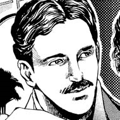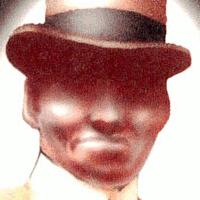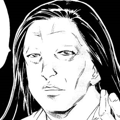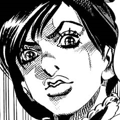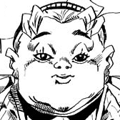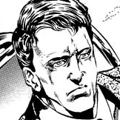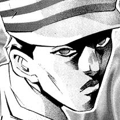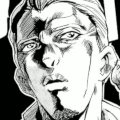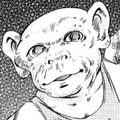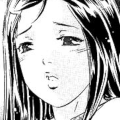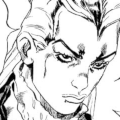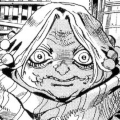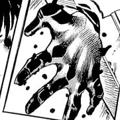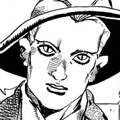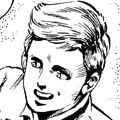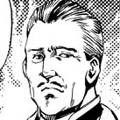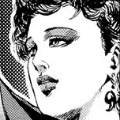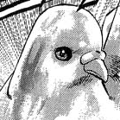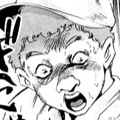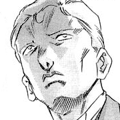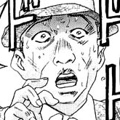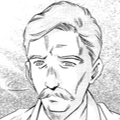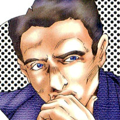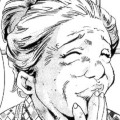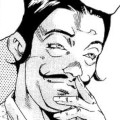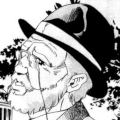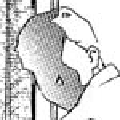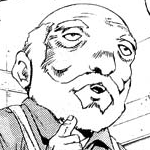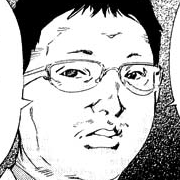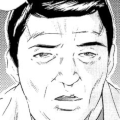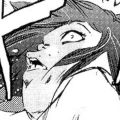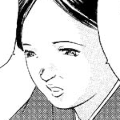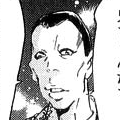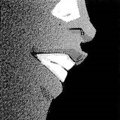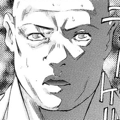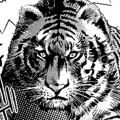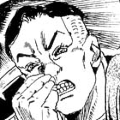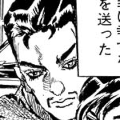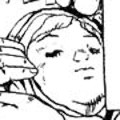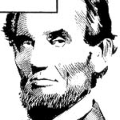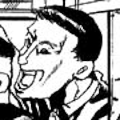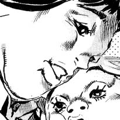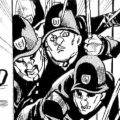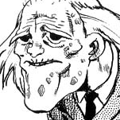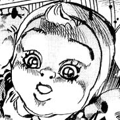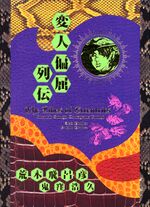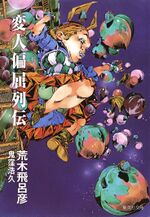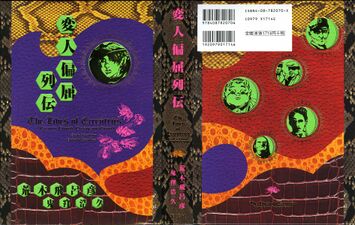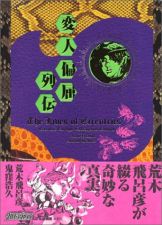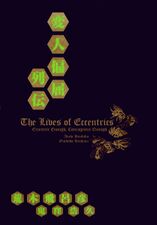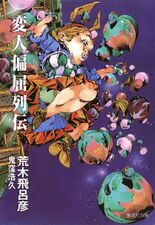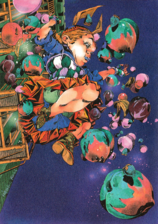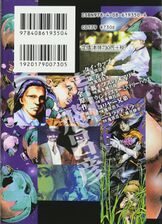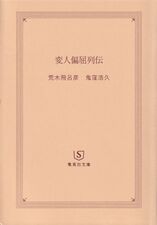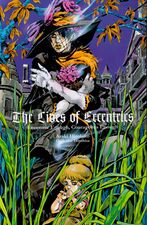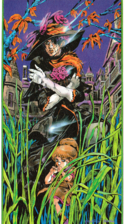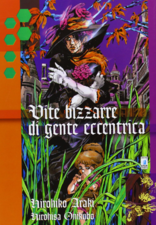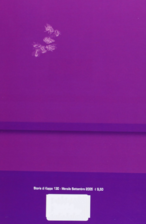The Lives of Eccentrics
Summary
The manga explores the lives of several famous eccentrics and bizarre real people. Each chapter features a different historical figure, narrating the course of their lives and focusing on a few notable events within them. While the manga attempts to respect the true story of each character, Araki takes some liberties in order to incorporate his own narrative style. The ultimate aim of the manga is to show the fascinating and even somewhat-respectable methods in which these eccentric and unconscionable people live their lives.
Though every chapter is written by Hirohiko Araki, Winchester Mystery House and Typhoid Mary are the only chapters drawn by him. The other chapters were drawn by Hirohisa Onikubo, with Nobuyuki Fujii assisting him for Nikola Tesla.
Personalities
- Nikola Tesla (ニコラ・テスラ, Nikora Tesura): An eccentric Serbian-American scientist and engineer known for his rivalry with Thomas Edison, particularly over his own invention of alternating current electricity.
- Ty Cobb (タイ・カッブ, Tai Kabbu): An American League baseball player renowned for his great skill, irritable character, and unbridled arrogance.
- The Collyer Brothers (コリヤー兄弟, Koriyā-Kyōdai): Two American brothers who were known for their hoarding habits and obsession with privacy, to the point of filling their own house with deadly traps to protect from burglars.
- Yoshio Kou (康 芳夫, Kō Yoshio): A Chinese-Japanese producer and showman who, desiring to show Japan the strangest things imaginable, attempted to air an alleged human-chimpanzee hybrid named Oliver mating with a human woman on live television.
- Sarah Winchester, owner of the Winchester Mystery House (ウィンチェスター・ミステリー・ハウス, Winchesutā Misuterī Hausu): An American woman who, believing the ghosts of Civil War soldiers sought revenge on her, began continuously constructing a labyrinthine mansion in San Jose, California.
- Mary Mallon, a.k.a. Typhoid Mary (腸チフスのメアリー, Chō-Chifusu no Mearī): An Irish-American woman identified as the first asymptomatic carrier of the Typhoid fever pathogen, who spread the disease by working as a cook in New York City.
Episodes
| No. | Title | Magazine | Release Date | Illustrator | Writer |
|---|---|---|---|---|---|
| 1 | Episode 1: Nikola Tesla | Super Jump | June 1, 1989[1] | Hirohisa Onikubo | Hirohiko Araki |
| 2 | Episode 2: Ty Cobb | Manga Allman | May 3, 2001 (Part 1)[2] | ||
| May 16, 2001 (Part 2)[3] | |||||
| 3 | Episode 3: Collyer Brothers | December 28, 2002[3] | |||
| 4 | Episode 4: Yoshio Kou | Ultra Jump | February 19, 2003[4] | ||
| 5 | Episode 5: Winchester Mystery House | July 19, 2003[5] | Hirohiko Araki | ||
| 6 | Episode 6: Typhoid Mary | August 19, 2003[6] |
Characters
Chapters
- History's Greatest Hitting Machine! Ty Cobb (史上最高!強打製造機『タイ・カッブ』, Shijō Saikō! Kyōda Seizōki "Tai Kabbu")
- Showman of the Century Who Launched Oliver: Yoshio Kou (オリバー君を仕掛けた世紀の興行師『康 芳夫』, Oribā-kun o Shikaketa Seiki no Kōgyōshi "Kō Yoshio")
- The Ultimate Choice That Actually Existed: Typhoid Mary (実在した究極の選択『腸チフスのメアリー』, Jitsuzai-shita Kyūkyoku no Sentaku "Chō-Chifusu no Mearī")
- The Mysterious Manor the Widow Kept Expanding: Winchester Mystery House (未亡人が増築しつづけた謎の館『ウィンチェスター・ミステリー・ハウス』, Mibōjin ga Zōchiku-shitsuzuketa Nazo no Yakata "Winchesutā Misuterī Hausu")
- The Brothers Nobody Knew: Collyer Brothers (誰も知らない兄弟『コリヤー兄弟』, Dare mo Shiranai Kyōdai "Koriyā-Kyōdai")
- The Genius Who Made Edison Cower: Nikola Tesla (エジソンを震えあがらせた大天才『ニコラ・テスラ』, Ejison o Furueagaraseta Daitensai "Nikora Tesura")
- The Genius Who Made Edison Cower: Nikola Tesla (エジソンを震えあがらせた大天才 ニコラ・テスラ, Ejison o Furueagaraseta Daitensai Nikora Tesura) (Super Jump - June 1989 / Manga Allman - No. 12, 2001)
- Ty Cobb (タイ・カッブ, Tai Kabbu) (Manga Allman - No. 10-11, 2001)
- The Brothers Nobody Knew: Collyer Brothers (誰も知らない兄弟 コリヤー兄弟, Dare mo Shiranai Kyōdai Koriyā-Kyōdai) (Manga Allman - No. 2, 2002)
- The Showman of the Century Who Launched Oliver: Yoshio Kou (オリバー君を仕掛けた世紀の興行師 康 芳夫, Oribā-kun o Shikaketa Seiki no Kōgyōshi Kō Yoshio) (Ultra Jump - February 19, 2003)
- ~The Mysterious Manor the Widow Kept Expanding~ Winchester Mystery House (〜未亡人が増築しつづけた謎の館〜 ウィンチェスター・ミステリー・ハウス, ~Mibōjin ga Zōchiku-shitsuzuketa Nazo no Yakata~ Winchesutā Misuterī Hausu) (Ultra Jump - July 19, 2003)
- Typhoid Mary (腸チフスのメアリー, Chō-Chifusu no Mearī) (Ultra Jump - August 19, 2003)
Author's Note
Or rather, what motive did I have in creating a series around that theme? I don't have an answer to that. But I've got to remember something, find some reason for it. I know it's in my mind somewhere.
When I was a kid, I heard about a famous mountaineer who was asked why he wanted to climb a mountain. The mountaineer's response was something to the effect of, "Because it's there." It was an answer I understood entirely, and yet one I couldn't understand at all. And, being a kid, thinking about the future, I thought, "Why do people choose the jobs or careers that they do?" Politicians, doctors, soldiers, clergymen, judges, and all the other prominent people in society... What made them want to take those positions? I felt that it was something I was incapable of understanding. And isn't it terrifying being, say, a karate practitioner, a racer, or a diver? Does whatever motive they have surpass that fear? Doctors have to see blood, and enemies attack karate practitioners all the time... It was a way of thinking I could never hope to possess.
Around the same time, I heard rumors in books or from acquaintances: that a French painter named Gauguin went to an island named Tahiti on the other side of the world just to paint, and passed away there; that there was a woman who continued to build her mansion for the rest of her life; that a man once lived for weeks on top of a chimney; that some scholars insisted that the inside of the earth is hollow, and that gravity allows us to gently enter the interior through a hole at the North Pole.
"What in the world? Why would someone do that? Why would they stake their lives on something like that? There's not much to be gained from it, but I can't help but feel there's something wonderful about it all...
What does it mean to be human, anyway?"
As a kid, I used to read and listen to stories like those with that thought in mind. And when I heard about those people, while I considered them fools, I also found myself listening to their stories with my full attention. I found myself feeling some kind of hope, or courage, or maybe empathy toward their foolish and worthless actions. I often get the feeling that I, too, act with no clear motive and fail without ever knowing the reason why. Within the lives of eccentrics exists an ode to humanity no different from that found in the biography of a great man. That is my motive in writing this series.
...That said, these biographies are based on facts, but I also had a set of selection criteria in mind. I read a lot of books and did a lot of searching to find individuals worth drawing, but it wasn't easy to find eccentrics who met my criteria. After all, my selection criteria was criteria for an ode to humanity. That strict selection criteria is as follows:
Hurdle No. 1: An eccentric must believe that their actions give people hope or peace of mind. (It wouldn't do to depict, say, a criminal.)
Hurdle No. 2: An eccentric must keep up their eccentricity for the rest of their life. (Temporarily conspicuous spirits and those who give in later in their lives are false eccentrics, and do not deserve respect.) In other words, it has to come naturally to him or her.
Hurdle No. 3: An eccentric triumphs over their enemies. (However you want to interpret triumph, it always involves winning against some kind of enemy.)
…というか、どういう動機でこういうテーマで連作しようなどと思ったのだろうか?
その答えは良くわからない。でも思い出してなんらかの理由を見つけなくてはならない。自分の頭にあるような気がする。
子供の頃、よく聞いた話に「人はなぜ山に登るのか?」という、ある有名な登山家にした質問があった。その登山家は
「そこに山があるから」
……と答えたそうだ。なんだか、わかったような、わかんないような答えだ。
そして子供の頃、将来のことを考えてたら、思った。人はどういう理由で仕事とか職業を決めるのだろう?……と。だいたい政治家だとか医者だとか軍人だとか宗教家だとか裁判官だとか、そういう社会的にりっぱな人たちでさえ、なんでそういう仕事に就こうなんて思うわけ? ぜんぜん自分の概念の外だと感じていたし、空手家だのレーサーだのダイバーだの、恐ろしくないわけ? 動機はその恐怖を越えているのか? 医者とかは「血」をみたりするわけだし、空手家なんて敵が襲って来るんですよ……。絶対に自分にはありえないモノの考え方だと思っていた。
そんな時、フランスの画家でゴーギャンという人が、絵を描くだけのために地球の裏側のタヒチまで行って、そこで死んだという話や、一生、屋敷を増築し続けた女の人がいただとか、煙突のてっぺんで何週間も生活し続けた男がいただとか、地球の内部は空洞になっていて北極の穴とかから重力のために
いったい何なのだ? なぜそういう事をするんだろう? どうしてそういう事に命を掛けるれるんだろう? 何かトクになる事はあまりないような気がするけど、でもなんかチョッピリすばらしいモノがあるような気がしないでもないしぃ……。
「
子供の頃、そんな風に感じてこういった話を読んでだり聞いたりしていた。そして、こういう人たちの話を聞いた時、「愚かな人々」と思う反面、すごい集中力で話を聞く自分を発見するし、同時にその『愚かな得にもならない行為』に、なにか「希望」だとか「勇気」だとか奇妙な「共感」といったモノを感じずにはいられないのも事実。自分だって動機不明の行動や、理由も分らず失敗したなあ〜と思う事がしょっちゅう。奇人偏屈の人々の人生には、偉人伝と何ら変わる事のない『人間讃歌』が存在するのだ。それがこの列伝を描こうと思った動機である。
……とはいうものの、この列伝は事実を基に構成されているのだが、選考基準というモノも存在する。いろんな本を読み、いろいろ探して描く人物を決めたわけだけれど、なかなか選考基準を満たす人っているわけではなかった。「選考基準」イコール「人間讃歌基準」でもあるわけである。その厳正なる選考基準は以下のとおり。
ハードル①
変人偏屈な人は、その行為が人々に「希望」と「安心」を与える魅力がなくてはならない。(たとえば犯罪者だとかはダメである)
ハードル②
変人偏屈な人は、その行為を一生やり続けていなくてはならない(一時の目立とう精神や、人生の途中でやめた人は本物ではなくニセ奇人なので、尊敬に値しない)。つまり彼(彼女)たちは自然体なのだ。
ハードル③
変人偏屈な人は、敵に勝利している。(勝利にはいろいろな解釈があるけれど、とにかく敵に勝っている事)
もう一度いいます。彼らを見習えという事ではありません。彼らは決して社会の異端とかではなく、人並みはずれた情熱を持った唯一無二の人々であり、これからの人間の未来に生きる「希望」と「安心」を与えてくれる「存在」なのです。
The Lives of Eccentrics was my first work published in a magazine, so I have nothing but nostalgic memories of Nikola and all the other stories. Originally, Mr. Araki was supposed to be in charge of the series all the way up to the page layout, but as you all know, he was working on a weekly serialization and didn't have time to draw one-shots. So I, who had recently been brought on as an assistant, was placed in charge of the series instead. Without this work, Onikubo would not be the manga artist he is today, and I can't thank Mr. Araki enough. (And thanks to Fujii, too, for co-writing the story for Nikola.)
But when I went to reread it, all I could see was my poor drawing style, and I just had to hold my head and think to myself, "Agh, everything about this needs fixing! I can't let it become a volume..." But in the end, I gave up and decided to accept it as just another Araki manga.
If I hadn't worked with Mr. Araki on this project, I only would've known about Nikola and Ty Cobb, but I wouldn't have understood how problematic they were. Ty Cobb, for example, would have ended up as the batter who heard everything, just how I knew him as a boy, and Nikola would've been the great man who invented alternating current. The only one mentioned in this book who is still alive is Yoshio Kou, the man behind Oliver, but I myself was deceived by him. (Though, is it really fair to say I was deceived?) Judging by that, I might have found it interesting to live alongside the great men of the world in real-time.
It's funny to imagine how people were pushed around by these great eccentrics back then. I hope you enjoy this book with that image in your mind.私にとっても、この『変人偏屈列伝』は初の雑誌掲載にあたりますので、「ニコラ」などは懐かしい想いで一杯です。本来なら、このシリーズは作面まで荒木先生が担当する筈でしたが、皆さんもご承知のように週刊連載をされている先生が読切を描く時間がない為、当時アシスタントとして入ったばかりの私が担当させていただきました。この作品がなければ、今の「漫画家」としての鬼窪は無かったと思うと、荒木先生には感謝してもし足りない位です(「ニコラ」で共同作面してくれた藤井クンもサンキュ)。
ただ改めて見返してみると、自分の作面の拙さがモロ前面に出ていて「あ〜全部直してェー。コミックスにしたくない〜」と頭抱えてゴロゴロしてますが、諦めて「これもひとつの荒木漫画だ」と納得する事にしました。
荒木先生と組んでこの仕事をしていなければ、ニコラやタイ・カッブなどは知ってるだけで「本当はンなヤなヤツだったんだ」と判らないままだったと思います。タイ・カッブなどは、私が少年時代に知っていた「挙ひとつ聞けてバットを持つ選手」で終わっていた筈ですし、ニコラなども「交流を発明した偉い人」でした。この本で取り上げてる人物で存命しているのは「オリバー君」の康芳夫氏だけですが、この方には私自身も騙されたワケで(騙されたっていうのは御幣がありますかネ)、そういった意味では、地の偉人達とリアルタイムで生きていたらもっと面白く感じたのかもしれません。
